
dravid
dravid (drd) cli is an AI powered cli coding framework
Stars: 114
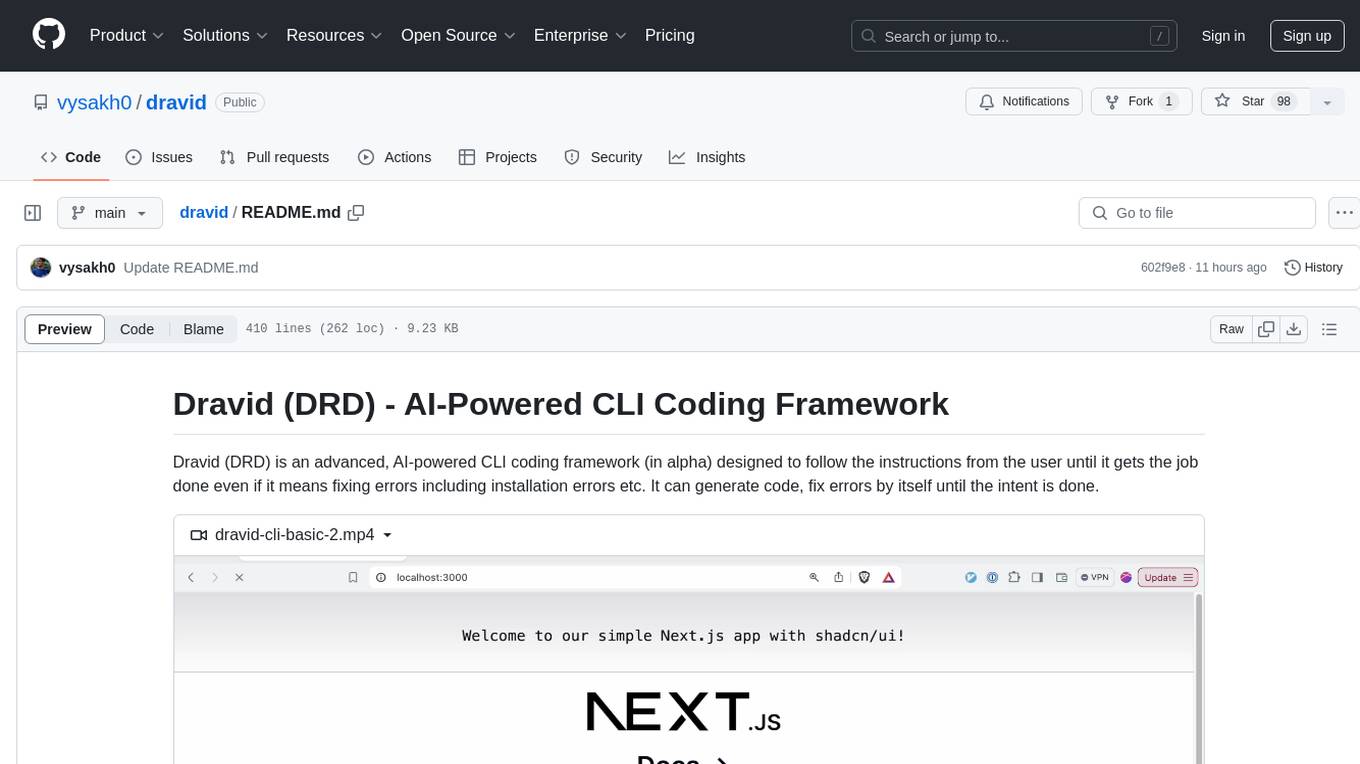
Dravid (DRD) is an advanced, AI-powered CLI coding framework designed to follow user instructions until the job is completed, including fixing errors. It can generate code, fix errors, handle image queries, manage file operations, integrate with external APIs, and provide a development server with error handling. Dravid is extensible and requires Python 3.7+ and CLAUDE_API_KEY. Users can interact with Dravid through CLI commands for various tasks like creating projects, asking questions, generating content, handling metadata, and file-specific queries. It supports use cases like Next.js project development, working with existing projects, exploring new languages, Ruby on Rails project development, and Python project development. Dravid's project structure includes directories for source code, CLI modules, API interaction, utility functions, AI prompt templates, metadata management, and tests. Contributions are welcome, and development setup involves cloning the repository, installing dependencies with Poetry, setting up environment variables, and using Dravid for project enhancements.
README:
Dravid (DRD) is an advanced, AI-powered CLI coding framework (in alpha) designed to follow user instructions until the job is done, even if it means fixing errors, including installation issues. It can generate code and fix errors autonomously until the intended result is achieved.
- Always try in a new directory for a fresh project.
- For existing projects, create a separate git branch or a sandbox environment. Monitor the generated commands. Git add or commit when you get results.
- Your file content will be sent to the CLAUDE API LLM for response. Do not include sensitive files in the project.
- Don't use hardcoded API_KEYS. Use .env and ensure it's part of .gitignore so the tool can skip reading it.
- Please use version 0.8.0 or higher. You can check the version with drd --version.
- If possible try in a docker instance.
- As shown in the video, when initializing a project where system dependencies don't exist, Dravid will attempt to fix them one by one, even if those fixes result in their own errors
https://github.com/user-attachments/assets/07784a9e-8de6-4161-9e83-8cad1fa04ae6
- If you have a dev server with import or reference errors, requiring dependency installation or fixes, Dravid will monitor your dev or test server and autofix. This is particularly useful for existing projects where you want to fix tests or refactor the entire project.
https://github.com/user-attachments/assets/14350e4d-6cec-4922-997f-f34e9f716189
You can also initialize Dravid in your existing project. See the Usage section for more details.
- AI-powered CLI for efficient coding and project management
- Image query handling capabilities
- Robust file operations and metadata management
- Integration with external APIs (Dravid API)
- Built-in development server with file monitoring
- Comprehensive error handling and reporting
- Extensible architecture for easy feature additions
- Python 3.7+
- pip (Python package installer)
- CLAUDE_API_KEY (environment variable should be set)
To install Dravid, run the following command:
pip install dravid
To upgrade for latest fixes
pip install --upgrade dravid
Always create a fresh directory before trying to create a new project.
After installation, you can use the drd command directly from your terminal. Here are some common usage examples:
NOTE: for better results, go step by step and communicate clearly. You can also define project_guidelines.txt which will be referenced in the main query, you can use this to instruct on how the code should be generated etc.
Also, any png or jpg files that will be generated and needs to be replaced will have placeholder prefix, so you know that it has to be replaced.
Execute a Dravid command:
drd "create a nextjs project"
The above command loads project context or project guidelines if they exist, along with any relevant file content in its context.
When you have larger string or if you want to copy paste a error stack with double quotes etc, please use this.
drd <<EOF
Fix this error:
....
EOF
Ask questions or generate content:
drd --ask "how is the weather"
Generate a file directly:
drd --ask "create a MIT LICENSE file, just the file, don't respond with anything else" >> LICENSE
--ask is much faster than the execute command because it doesn't load project context or project guidelines (you can create your own project_guidelines.txt)
Use image references in your queries:
drd "make the home image similar to the image" --image "~/Downloads/reference.png"
You can run the development server with automatic error fixing.
This command will start your dev server (as in the drd.json) and then continually fix any errors and then restart, you can sitback and sip coffee :)
drd --hf
or
drd --hot-fix
You can also pass custom cmd options to --hf then it will pick that command over the dev server command.
This useful especially if you have test runners.
If you have 100 test cases, and 10 of the file, you can set this command to identify errors and automatically fix
drd --hf --cmd "npm run test:watch"
or
drd --hf --command "poetry run test:watch"
It would work with any languages or frameworks, make sure that the command is a continually running one not the usual test script which exits out after tests passes or fails.
To use Dravid cli in an existing project you would have to initialize metadata (drd.json)
This script will ignore files in your .gitgnore and recursively read and give description for each of the file
drd --meta-init
or
drd --i
Note: make sure to include as many things in .gitignore that are not relevant. This would make multiple LLM calls.
When you have added some files or removed files on your own for some reason and you want Dravid to know about it, you have to run this:
drd --meta-add "modified the about page"
or
drd --a "added users api"
This would update the drd.json
Ask for suggestions on specific files:
drd --ask "can you suggest how to refactor this file" --file "src/main.py"
For more detailed usage instructions and options, use the help command:
drd --help
-
Create a simple Next.js app:
drd "create a simple nextjs app" -
Include shadcn components:
drd "include shadcn components like button, input, select etc" -
Modify home page based on a reference image:
drd "make the home page similar to the image" --image ~/Downloads/reference.png -
Create additional pages with consistent layout:
drd "whatever links like Company, About, Services etc that you see in Nav link you can convert them into links and page on its own and with some sample content. All these new pages should have the same layout as the home page" -
Auto-fix errors and start development server:
drd --hf
Initialize Dravid in an existing project:
drd --i
This creates a drd.json based on the existing folder structure, allowing you to start using Dravid in that project.
-
Create a simple Elixir project (even if Elixir is not installed):
drd "create a simple elixir project"Dravid will auto-fix any errors, including installing necessary dependencies.
-
Handle specific errors:
drd <<EOF Your error trace in "file" EOF
-
Create a new Rails project:
drd "create a new Ruby on Rails project with PostgreSQL database" -
Generate a scaffold for a resource:
drd "generate a scaffold for a Blog model with title and content fields" -
Set up authentication:
drd "add Devise gem for user authentication" -
Create a custom controller and views:
drd "create a controller for static pages with home, about, and contact actions, including corresponding views" -
Implement a feature based on an image:
drd "implement a comment section for blog posts similar to the image" --image ~/Downloads/comment_section.png -
Run migrations and start the server:
drd "run database migrations and start the Rails server" -
Auto-fix any errors:
drd --hf
-
Set up a new Python project with virtual environment:
drd "create a new Python project with poetry for dependency management" -
Create a simple Flask web application:
drd "create a basic Flask web application with a home route and a simple API endpoint" -
Add database integration:
drd "add SQLAlchemy ORM to the Flask app and create a User model" -
Implement user authentication:
drd "implement JWT-based authentication for the Flask API" -
Create a data processing script:
drd "create a Python script that processes CSV files using pandas and generates a summary report" -
Add unit tests:
drd "add pytest-based unit tests for the existing functions in the project" -
Generate project documentation:
drd "generate Sphinx documentation for the project, including docstrings for all functions and classes" -
Auto-fix any errors or missing dependencies:
drd --hf
-
src/drd/: Main source code directory-
cli/: Command-line interface modules -
api/: API interaction and parsing modules -
utils/: Utility functions and helpers -
prompts/: AI prompt templates -
metadata/: Project metadata management
-
-
tests/: Test suite for the project
We welcome contributions to Dravid! Please see our Contributing Guide for more details on how to get started.
To install Dravid, you need Python 3.7+ and Poetry. Follow these steps:
-
Clone the repository:
git clone https://github.com/vysakh0/dravid.git cd dravid -
Install dependencies using Poetry:
poetry install -
Set up environment variables: Create a
.envfile in the project root and add your API keys:CLAUDE_API_KEY=your_claude_api_key_here -
You can use Dravid to add features or functionalities to the project. As this project uses drd.json and has used Dravid to build Dravid.
poetry run drd "refactor api_utils"
or
poetry run drd "add tests for utils/utils"
poetry run drd --ask "who are you"
https://github.com/user-attachments/assets/2bcd2969-2746-4115-a879-18b8333a3053
https://github.com/user-attachments/assets/15112577-0d45-44be-b564-74bee548ac66
https://github.com/user-attachments/assets/25b82c1f-e357-405b-9b85-2488a2d2b771
After adding some functionalities, if you want to test how it works, I suggest creating a directory
called myapp or testapp or test-app in the root of this project. These folder names are already in .gitignore.
cd myapp
poetry run drd "create a simple elixir project"
To run the test suite:
poetry run test
This project is licensed under the MIT License - see the LICENSE file for details.
- Special thanks to the creators of the Claude AI model, which powers many of Dravid's capabilities
For questions, suggestions, or issues, please open an issue on the GitHub repository or contact the maintainers directly.
Happy coding with Dravid!
For Tasks:
Click tags to check more tools for each tasksFor Jobs:
Alternative AI tools for dravid
Similar Open Source Tools

dravid
Dravid (DRD) is an advanced, AI-powered CLI coding framework designed to follow user instructions until the job is completed, including fixing errors. It can generate code, fix errors, handle image queries, manage file operations, integrate with external APIs, and provide a development server with error handling. Dravid is extensible and requires Python 3.7+ and CLAUDE_API_KEY. Users can interact with Dravid through CLI commands for various tasks like creating projects, asking questions, generating content, handling metadata, and file-specific queries. It supports use cases like Next.js project development, working with existing projects, exploring new languages, Ruby on Rails project development, and Python project development. Dravid's project structure includes directories for source code, CLI modules, API interaction, utility functions, AI prompt templates, metadata management, and tests. Contributions are welcome, and development setup involves cloning the repository, installing dependencies with Poetry, setting up environment variables, and using Dravid for project enhancements.
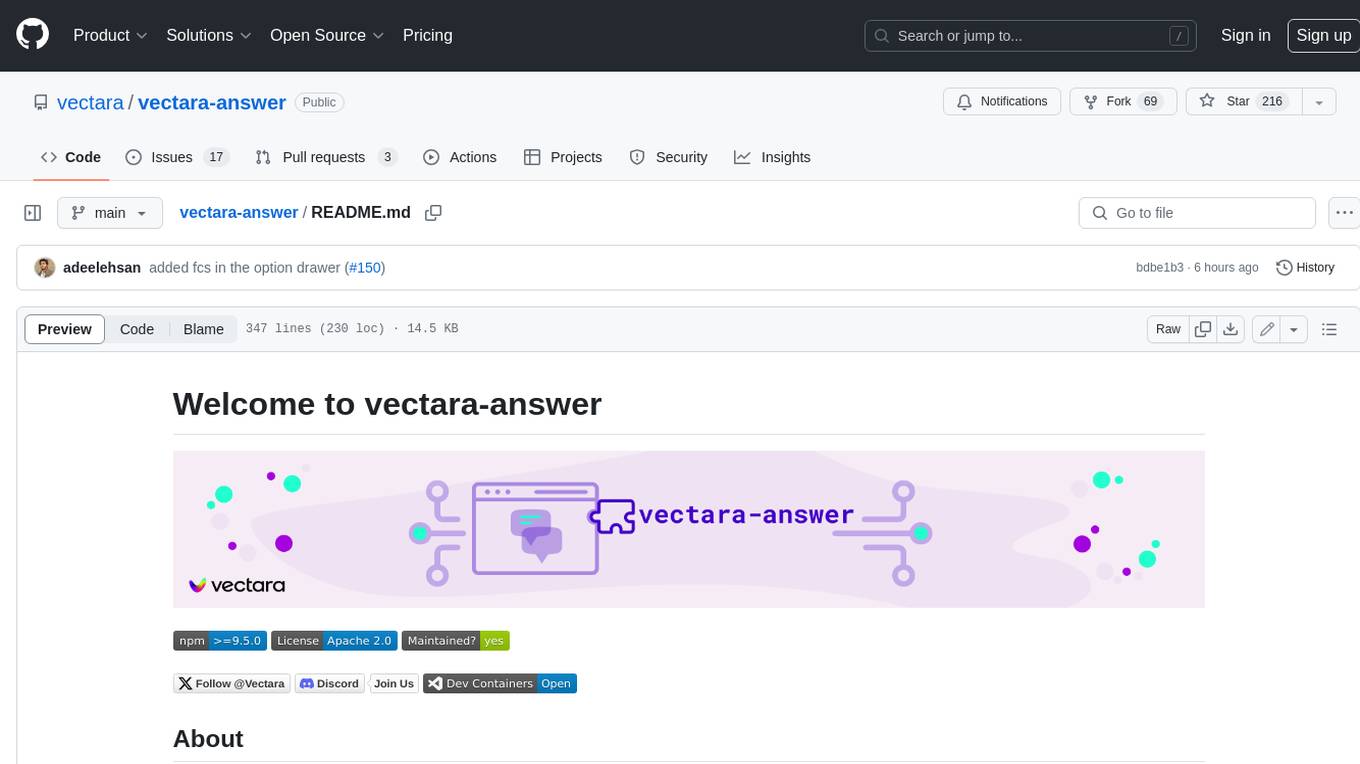
vectara-answer
Vectara Answer is a sample app for Vectara-powered Summarized Semantic Search (or question-answering) with advanced configuration options. For examples of what you can build with Vectara Answer, check out Ask News, LegalAid, or any of the other demo applications.
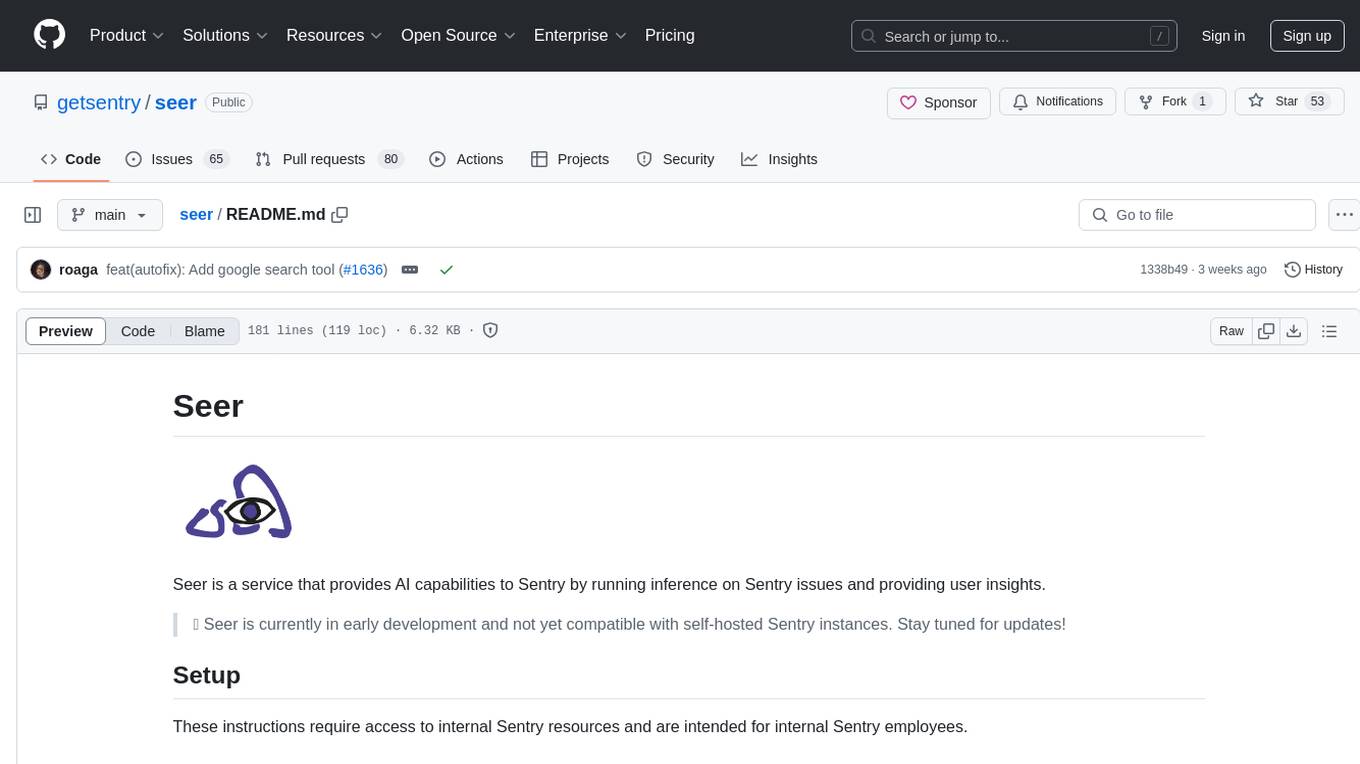
seer
Seer is a service that provides AI capabilities to Sentry by running inference on Sentry issues and providing user insights. It is currently in early development and not yet compatible with self-hosted Sentry instances. The tool requires access to internal Sentry resources and is intended for internal Sentry employees. Users can set up the environment, download model artifacts, integrate with local Sentry, run evaluations for Autofix AI agent, and deploy to a sandbox staging environment. Development commands include applying database migrations, creating new migrations, running tests, and more. The tool also supports VCRs for recording and replaying HTTP requests.
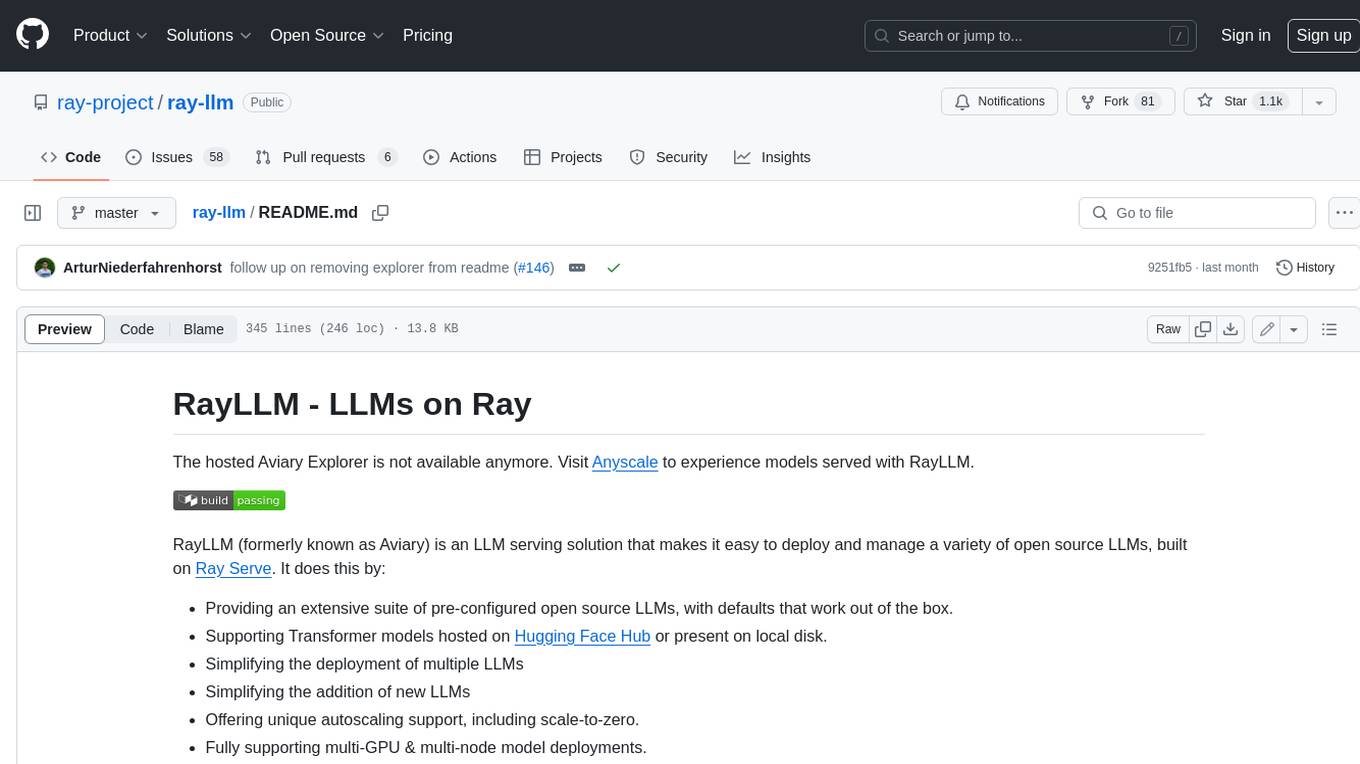
ray-llm
RayLLM (formerly known as Aviary) is an LLM serving solution that makes it easy to deploy and manage a variety of open source LLMs, built on Ray Serve. It provides an extensive suite of pre-configured open source LLMs, with defaults that work out of the box. RayLLM supports Transformer models hosted on Hugging Face Hub or present on local disk. It simplifies the deployment of multiple LLMs, the addition of new LLMs, and offers unique autoscaling support, including scale-to-zero. RayLLM fully supports multi-GPU & multi-node model deployments and offers high performance features like continuous batching, quantization and streaming. It provides a REST API that is similar to OpenAI's to make it easy to migrate and cross test them. RayLLM supports multiple LLM backends out of the box, including vLLM and TensorRT-LLM.
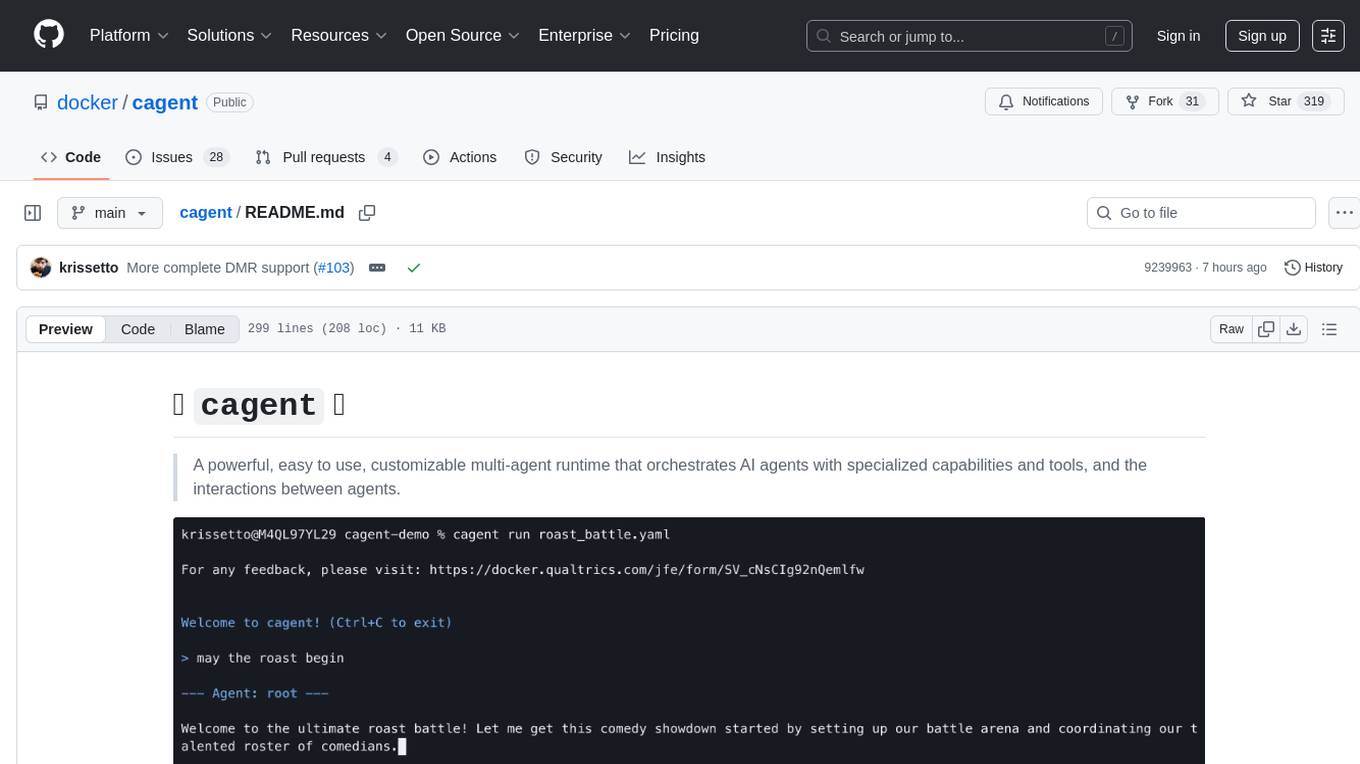
cagent
cagent is a powerful and easy-to-use multi-agent runtime that orchestrates AI agents with specialized capabilities and tools, allowing users to quickly build, share, and run a team of virtual experts to solve complex problems. It supports creating agents with YAML configuration, improving agents with MCP servers, and delegating tasks to specialists. Key features include multi-agent architecture, rich tool ecosystem, smart delegation, YAML configuration, advanced reasoning tools, and support for multiple AI providers like OpenAI, Anthropic, Gemini, and Docker Model Runner.
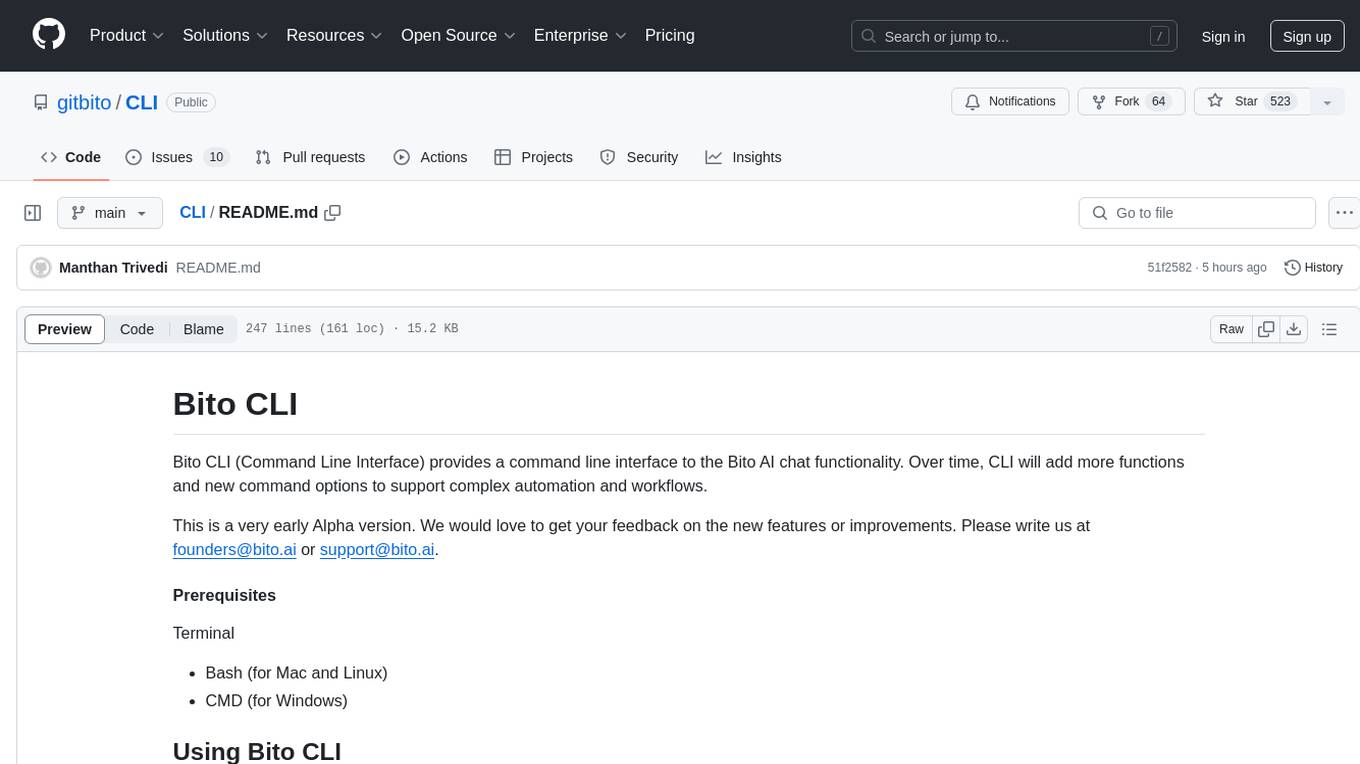
CLI
Bito CLI provides a command line interface to the Bito AI chat functionality, allowing users to interact with the AI through commands. It supports complex automation and workflows, with features like long prompts and slash commands. Users can install Bito CLI on Mac, Linux, and Windows systems using various methods. The tool also offers configuration options for AI model type, access key management, and output language customization. Bito CLI is designed to enhance user experience in querying AI models and automating tasks through the command line interface.
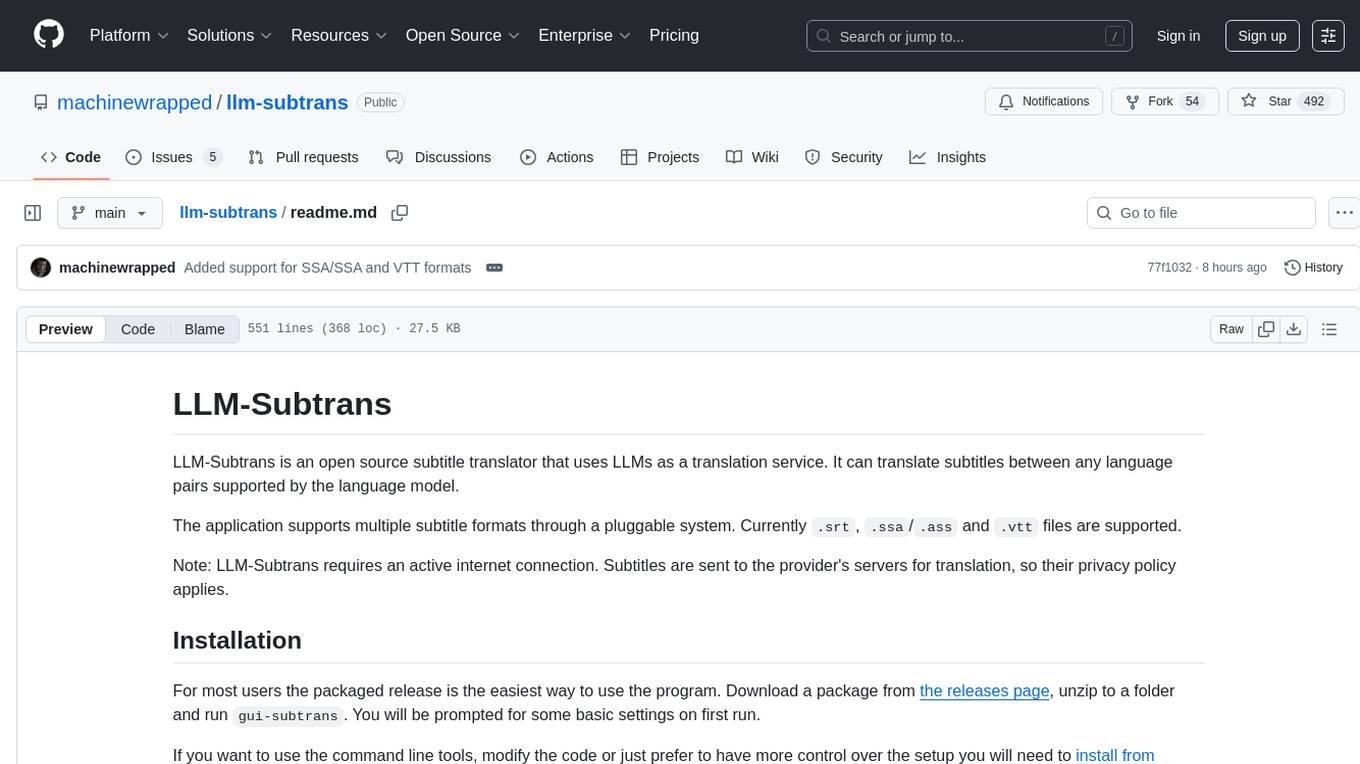
llm-subtrans
LLM-Subtrans is an open source subtitle translator that utilizes LLMs as a translation service. It supports translating subtitles between any language pairs supported by the language model. The application offers multiple subtitle formats support through a pluggable system, including .srt, .ssa/.ass, and .vtt files. Users can choose to use the packaged release for easy usage or install from source for more control over the setup. The tool requires an active internet connection as subtitles are sent to translation service providers' servers for translation.
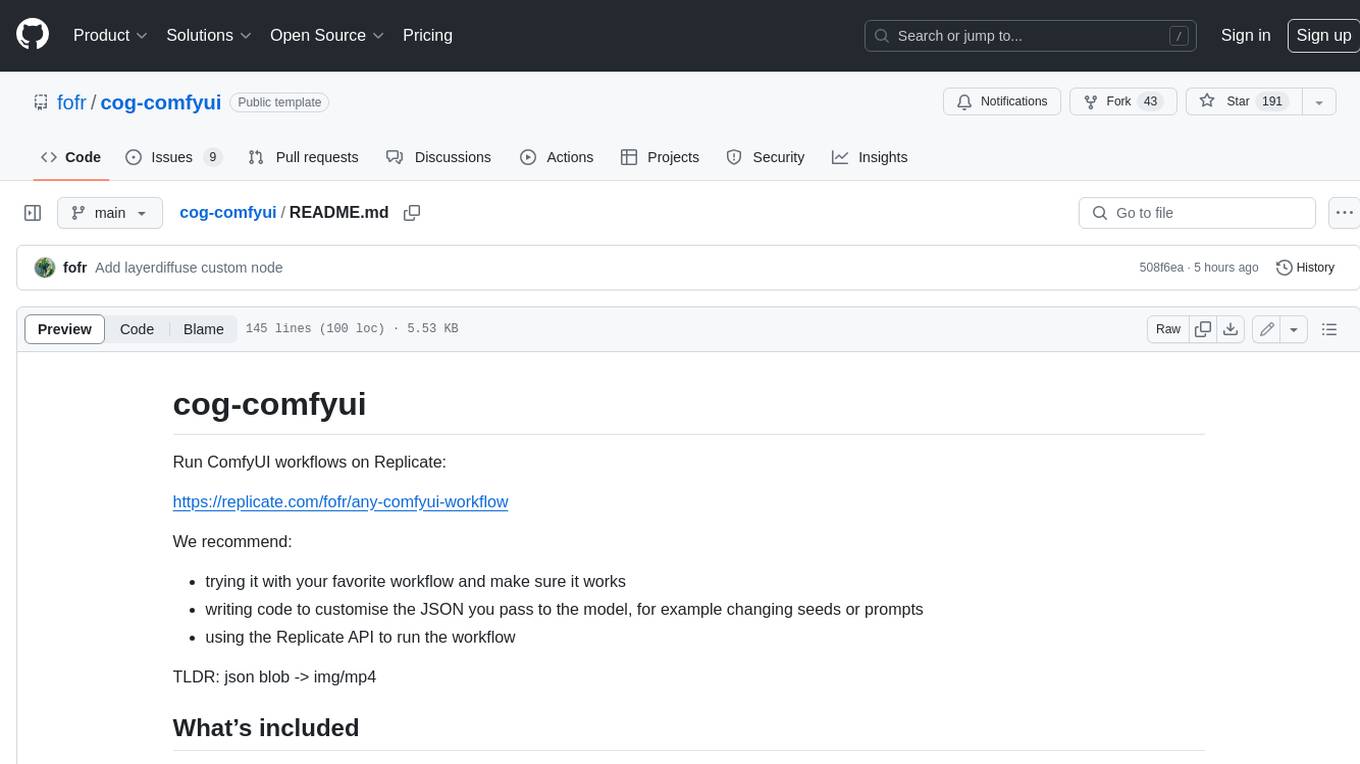
cog-comfyui
Cog-comfyui allows users to run ComfyUI workflows on Replicate. ComfyUI is a visual programming tool for creating and sharing generative art workflows. With cog-comfyui, users can access a variety of pre-trained models and custom nodes to create their own unique artworks. The tool is easy to use and does not require any coding experience. Users simply need to upload their API JSON file and any necessary input files, and then click the "Run" button. Cog-comfyui will then generate the output image or video file.

cog-comfyui
Cog-ComfyUI is a tool designed to run ComfyUI workflows on Replicate. It allows users to easily integrate their own workflows into their app or website using the Replicate API. The tool includes popular model weights and custom nodes, with the option to request more custom nodes or models. Users can get their API JSON, gather input files, and use custom LoRAs from CivitAI or HuggingFace. Additionally, users can run their workflows and set up their own dedicated instances for better performance and control. The tool provides options for private deployments, forking using Cog, or creating new models from the train tab on Replicate. It also offers guidance on developing locally and running the Web UI from a Cog container.
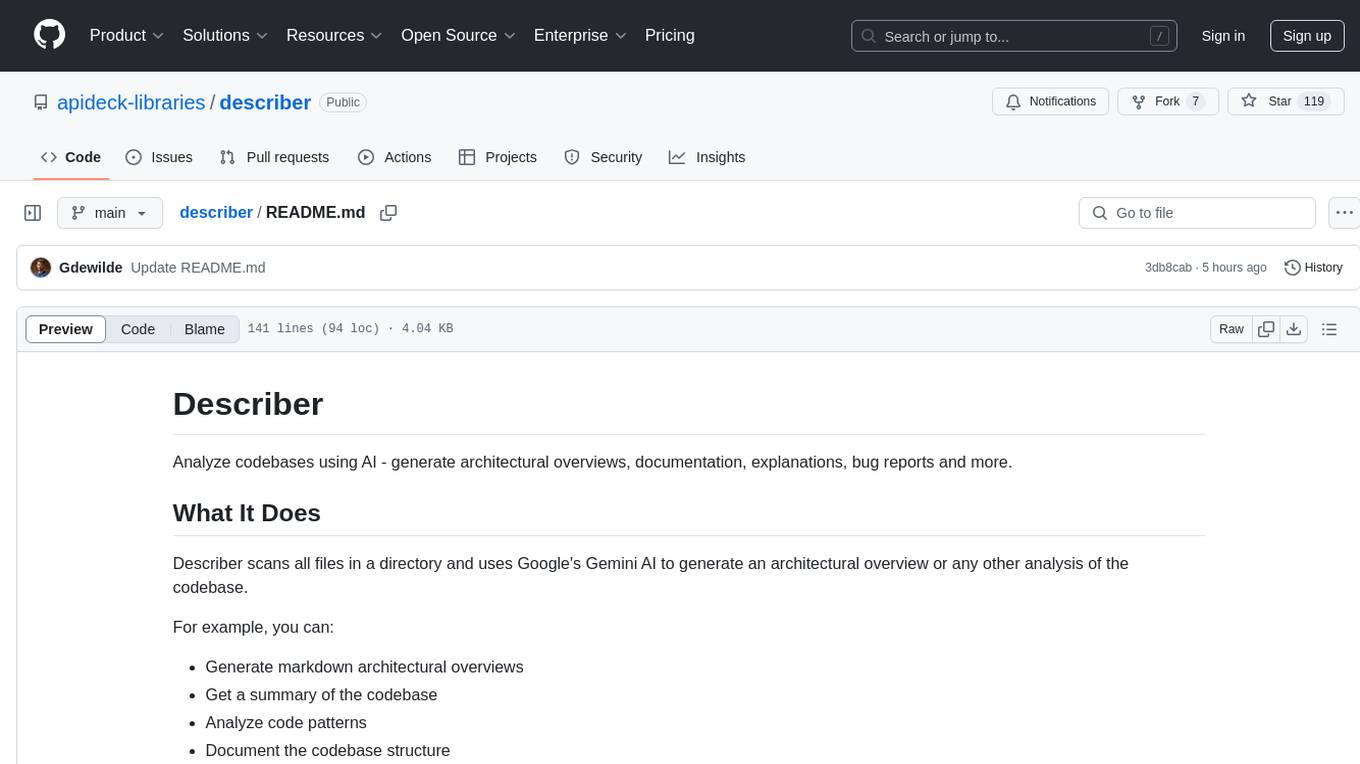
describer
Describer is a tool that analyzes codebases using AI to generate architectural overviews, documentation, explanations, bug reports, and more. It scans all files in a directory and uses Google's Gemini AI to provide insights such as markdown architectural overviews, codebase summaries, code pattern analysis, codebase structure documentation, bug identification, and test idea generation. The tool respects .gitignore rules by default but allows users to include/exclude specific files or patterns for analysis.
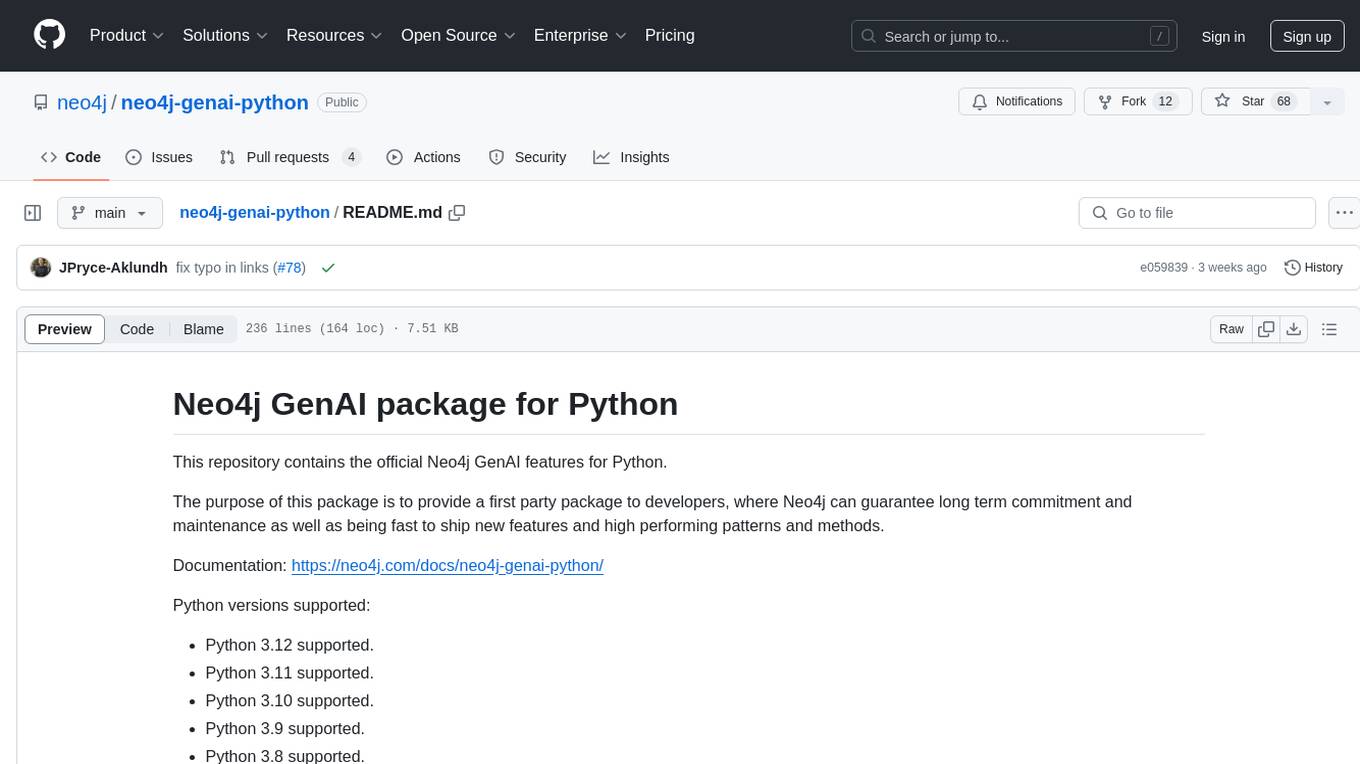
neo4j-genai-python
This repository contains the official Neo4j GenAI features for Python. The purpose of this package is to provide a first-party package to developers, where Neo4j can guarantee long-term commitment and maintenance as well as being fast to ship new features and high-performing patterns and methods.
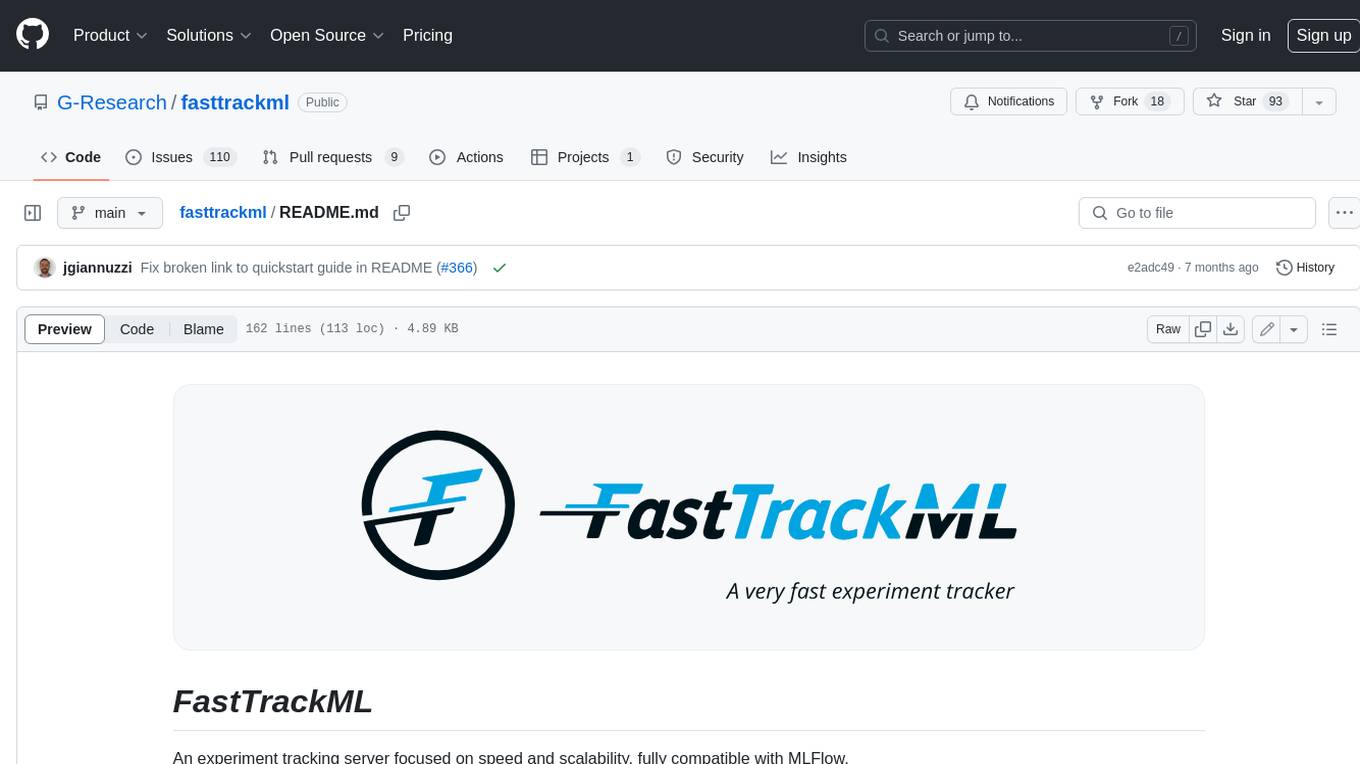
fasttrackml
FastTrackML is an experiment tracking server focused on speed and scalability, fully compatible with MLFlow. It provides a user-friendly interface to track and visualize your machine learning experiments, making it easy to compare different models and identify the best performing ones. FastTrackML is open source and can be easily installed and run with pip or Docker. It is also compatible with the MLFlow Python package, making it easy to integrate with your existing MLFlow workflows.
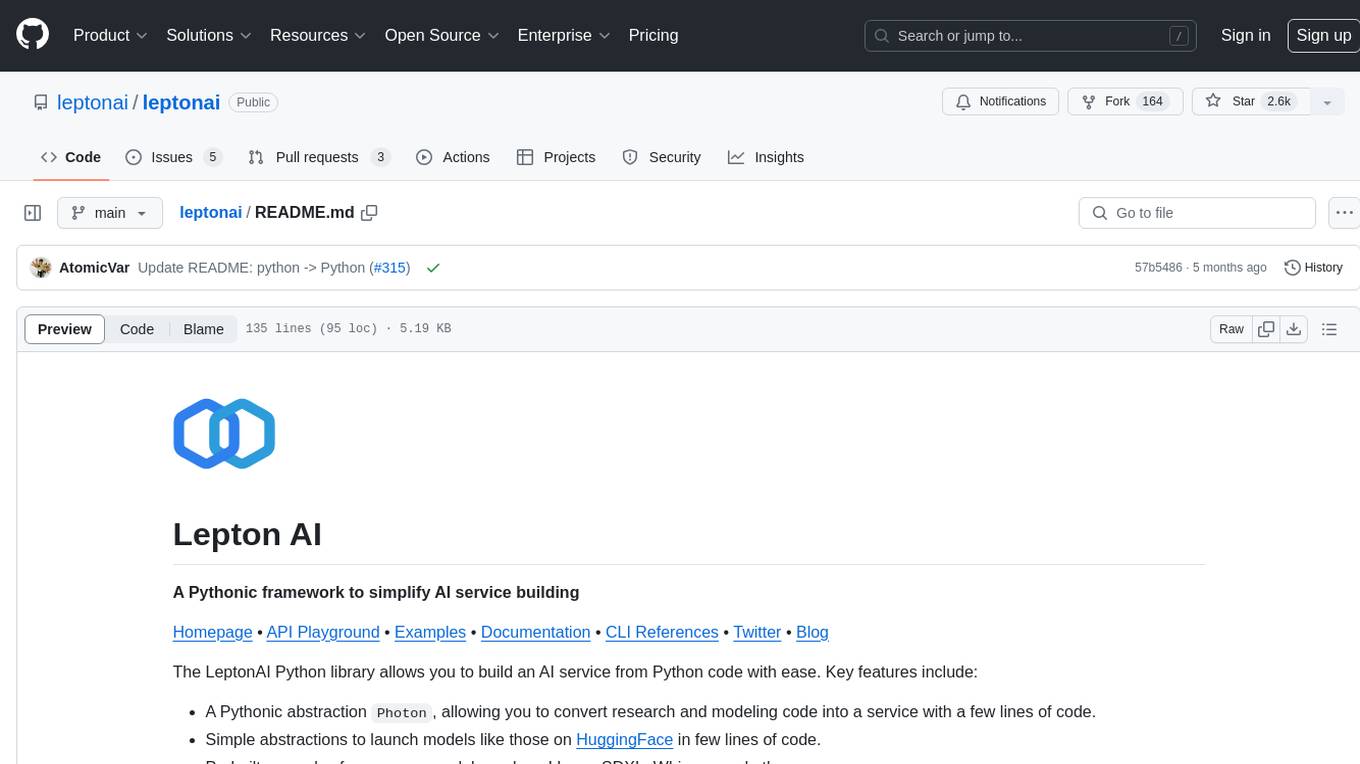
leptonai
A Pythonic framework to simplify AI service building. The LeptonAI Python library allows you to build an AI service from Python code with ease. Key features include a Pythonic abstraction Photon, simple abstractions to launch models like those on HuggingFace, prebuilt examples for common models, AI tailored batteries, a client to automatically call your service like native Python functions, and Pythonic configuration specs to be readily shipped in a cloud environment.
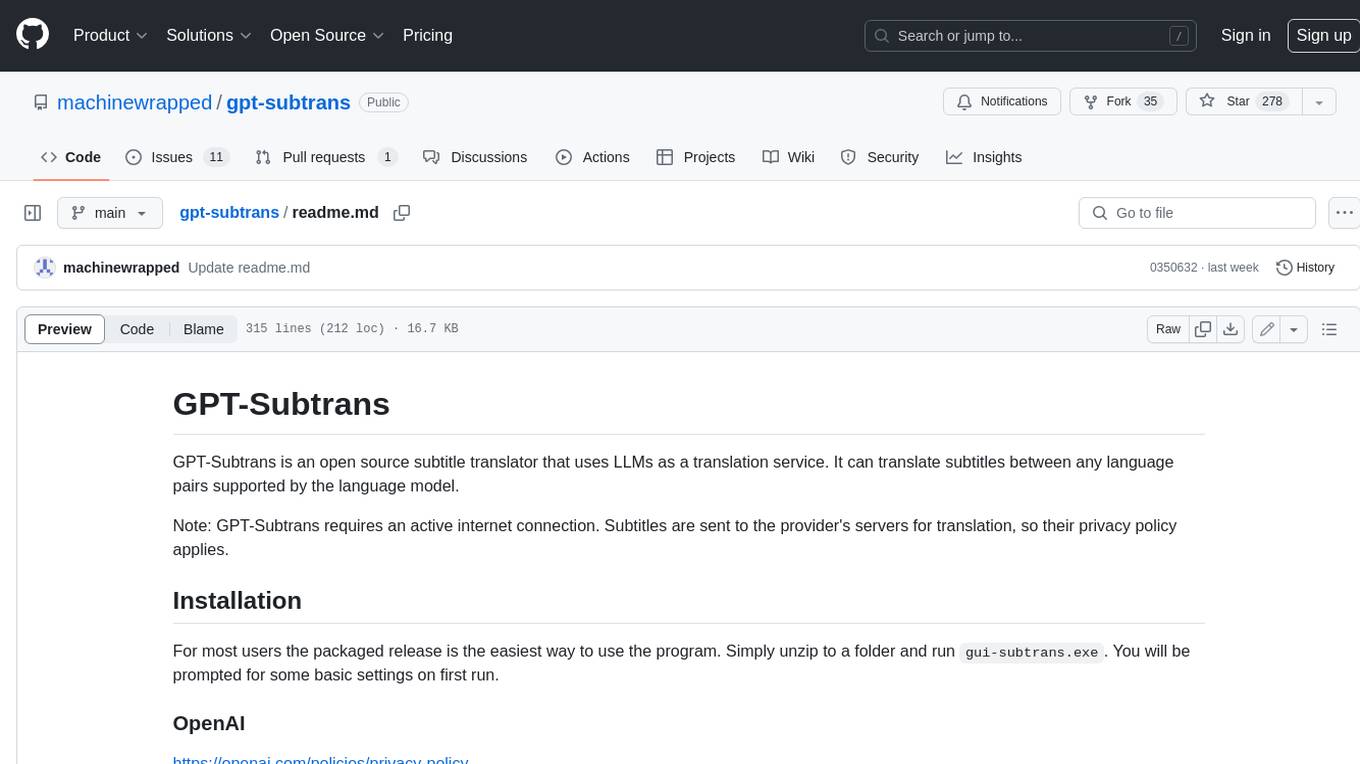
gpt-subtrans
GPT-Subtrans is an open-source subtitle translator that utilizes large language models (LLMs) as translation services. It supports translation between any language pairs that the language model supports. Note that GPT-Subtrans requires an active internet connection, as subtitles are sent to the provider's servers for translation, and their privacy policy applies.
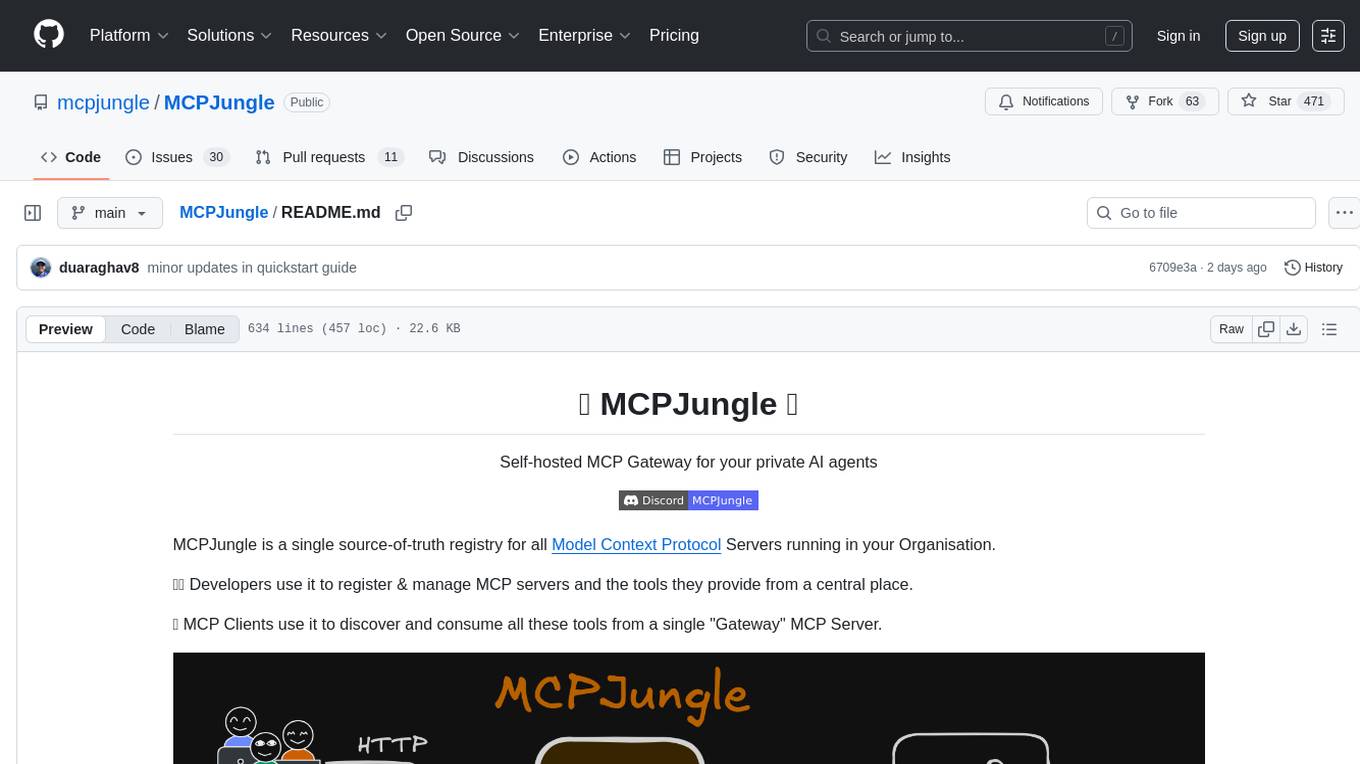
MCPJungle
MCPJungle is a self-hosted MCP Gateway for private AI agents, serving as a registry for Model Context Protocol Servers. Developers use it to manage servers and tools centrally, while clients discover and consume tools from a single 'Gateway' MCP Server. Suitable for developers using MCP Clients like Claude & Cursor, building production-grade AI Agents, and organizations managing client-server interactions. The tool allows quick start, installation, usage, server and client setup, connection to Claude and Cursor, enabling/disabling tools, managing tool groups, authentication, enterprise features like access control and OpenTelemetry metrics. Limitations include lack of long-running connections to servers and no support for OAuth flow. Contributions are welcome.
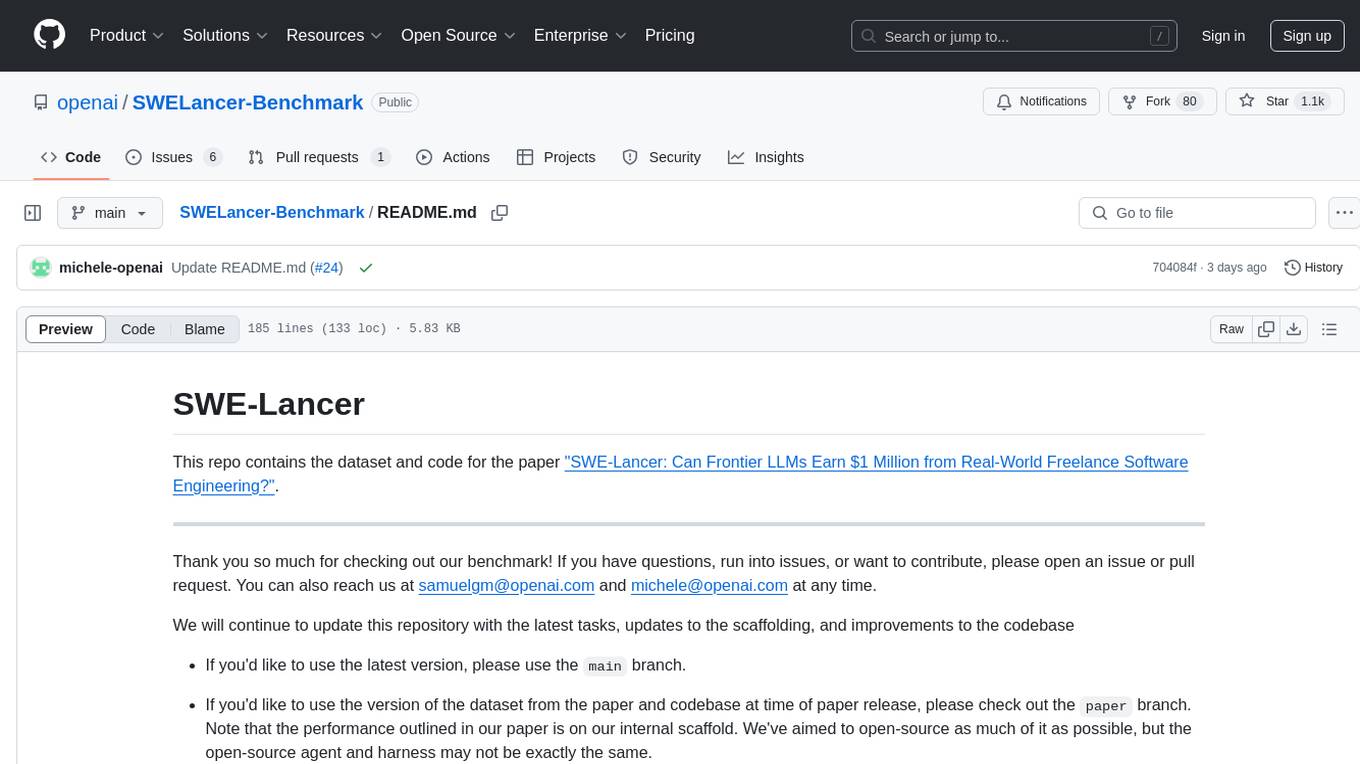
SWELancer-Benchmark
SWE-Lancer is a benchmark repository containing datasets and code for the paper 'SWE-Lancer: Can Frontier LLMs Earn $1 Million from Real-World Freelance Software Engineering?'. It provides instructions for package management, building Docker images, configuring environment variables, and running evaluations. Users can use this tool to assess the performance of language models in real-world freelance software engineering tasks.
For similar tasks

dravid
Dravid (DRD) is an advanced, AI-powered CLI coding framework designed to follow user instructions until the job is completed, including fixing errors. It can generate code, fix errors, handle image queries, manage file operations, integrate with external APIs, and provide a development server with error handling. Dravid is extensible and requires Python 3.7+ and CLAUDE_API_KEY. Users can interact with Dravid through CLI commands for various tasks like creating projects, asking questions, generating content, handling metadata, and file-specific queries. It supports use cases like Next.js project development, working with existing projects, exploring new languages, Ruby on Rails project development, and Python project development. Dravid's project structure includes directories for source code, CLI modules, API interaction, utility functions, AI prompt templates, metadata management, and tests. Contributions are welcome, and development setup involves cloning the repository, installing dependencies with Poetry, setting up environment variables, and using Dravid for project enhancements.
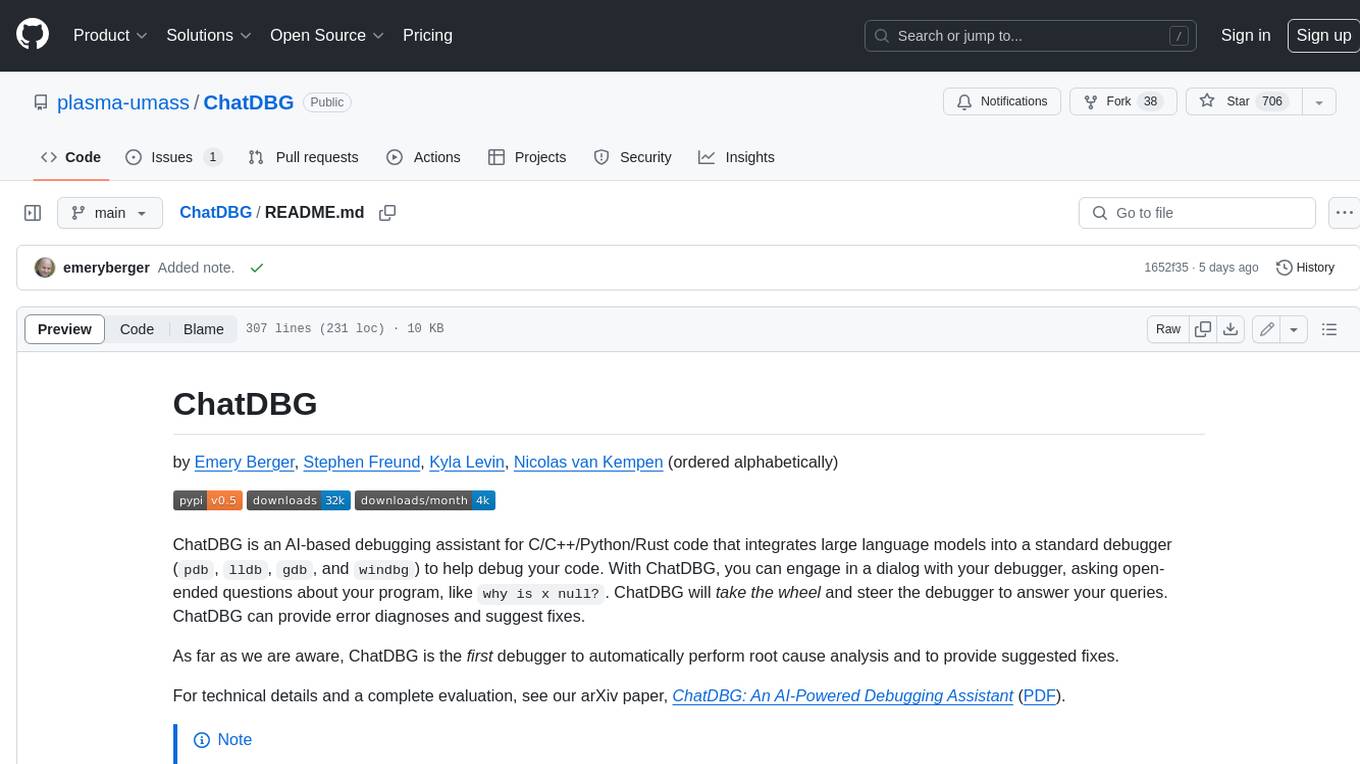
ChatDBG
ChatDBG is an AI-based debugging assistant for C/C++/Python/Rust code that integrates large language models into a standard debugger (`pdb`, `lldb`, `gdb`, and `windbg`) to help debug your code. With ChatDBG, you can engage in a dialog with your debugger, asking open-ended questions about your program, like `why is x null?`. ChatDBG will _take the wheel_ and steer the debugger to answer your queries. ChatDBG can provide error diagnoses and suggest fixes. As far as we are aware, ChatDBG is the _first_ debugger to automatically perform root cause analysis and to provide suggested fixes.
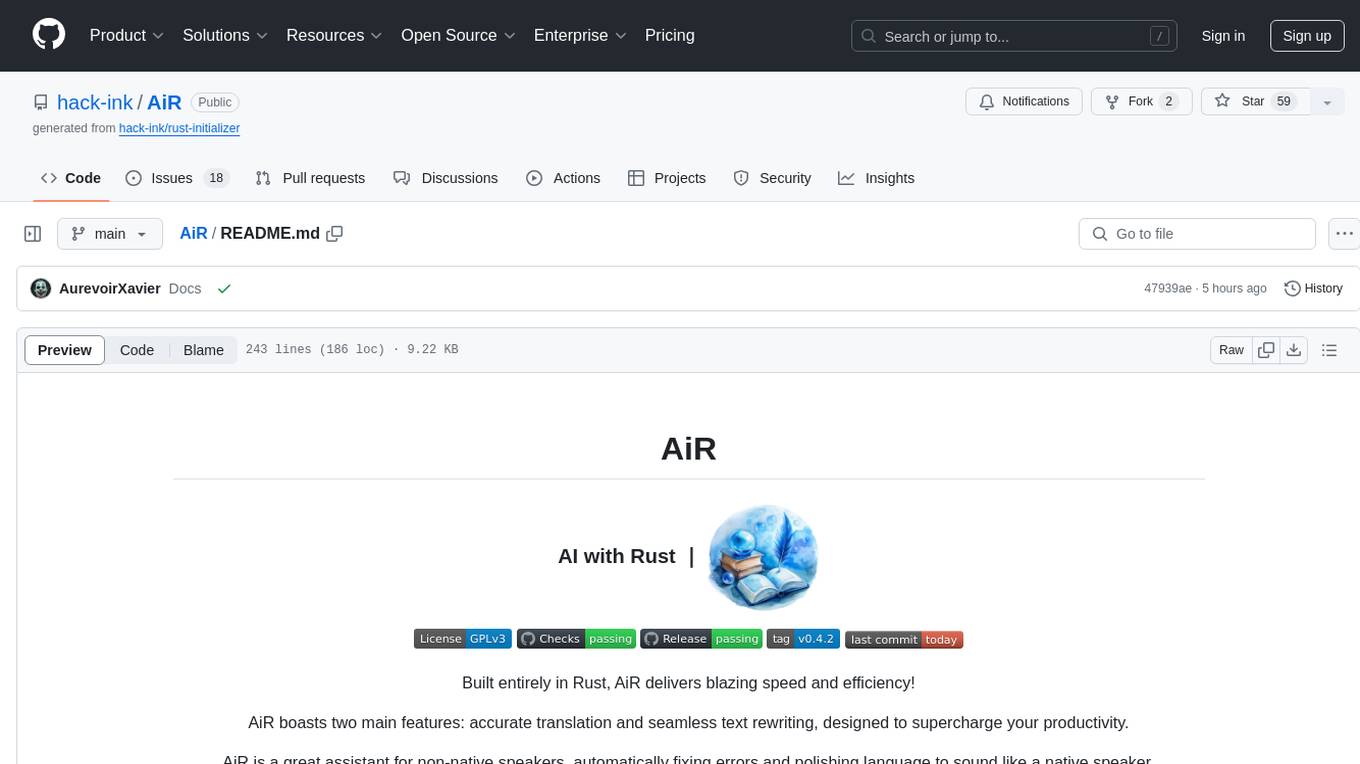
AiR
AiR is an AI tool built entirely in Rust that delivers blazing speed and efficiency. It features accurate translation and seamless text rewriting to supercharge productivity. AiR is designed to assist non-native speakers by automatically fixing errors and polishing language to sound like a native speaker. The tool is under heavy development with more features on the horizon.
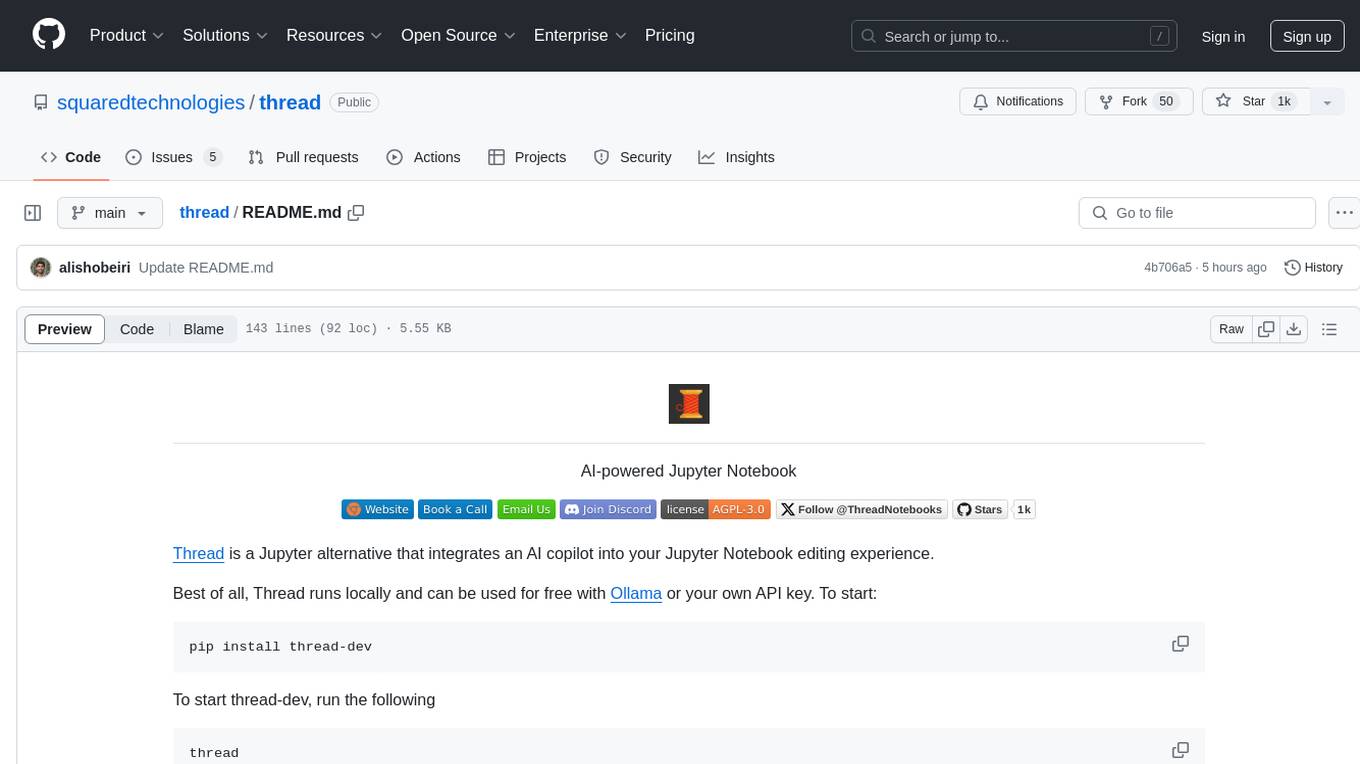
thread
Thread is an AI-powered Jupyter alternative that integrates an AI copilot into your editing experience. It offers a familiar Jupyter Notebook editing experience with features like natural language code edits, generating cells to answer questions, context-aware chat sidebar, and automatic error explanations or fixes. The tool aims to enhance code editing and data exploration by providing a more interactive and intuitive experience for users. Thread can be used for free with Ollama or your own API key, and it runs locally for convenience and privacy.
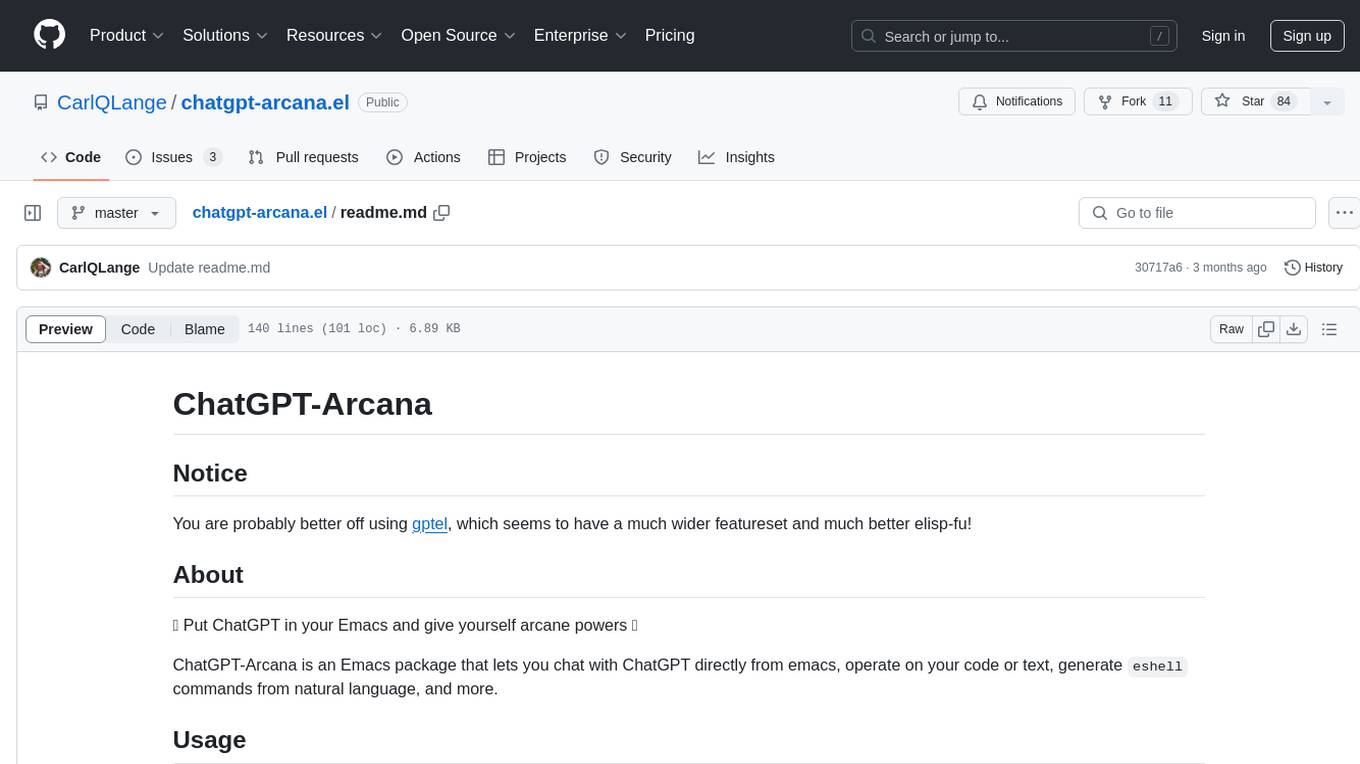
chatgpt-arcana.el
ChatGPT-Arcana is an Emacs package that allows users to interact with ChatGPT directly from Emacs, enabling tasks such as chatting with GPT, operating on code or text, generating eshell commands from natural language, fixing errors, writing commit messages, and creating agents for web search and code evaluation. The package requires an API key from OpenAI's GPT-3 model and offers various interactive functions for enhancing productivity within Emacs.
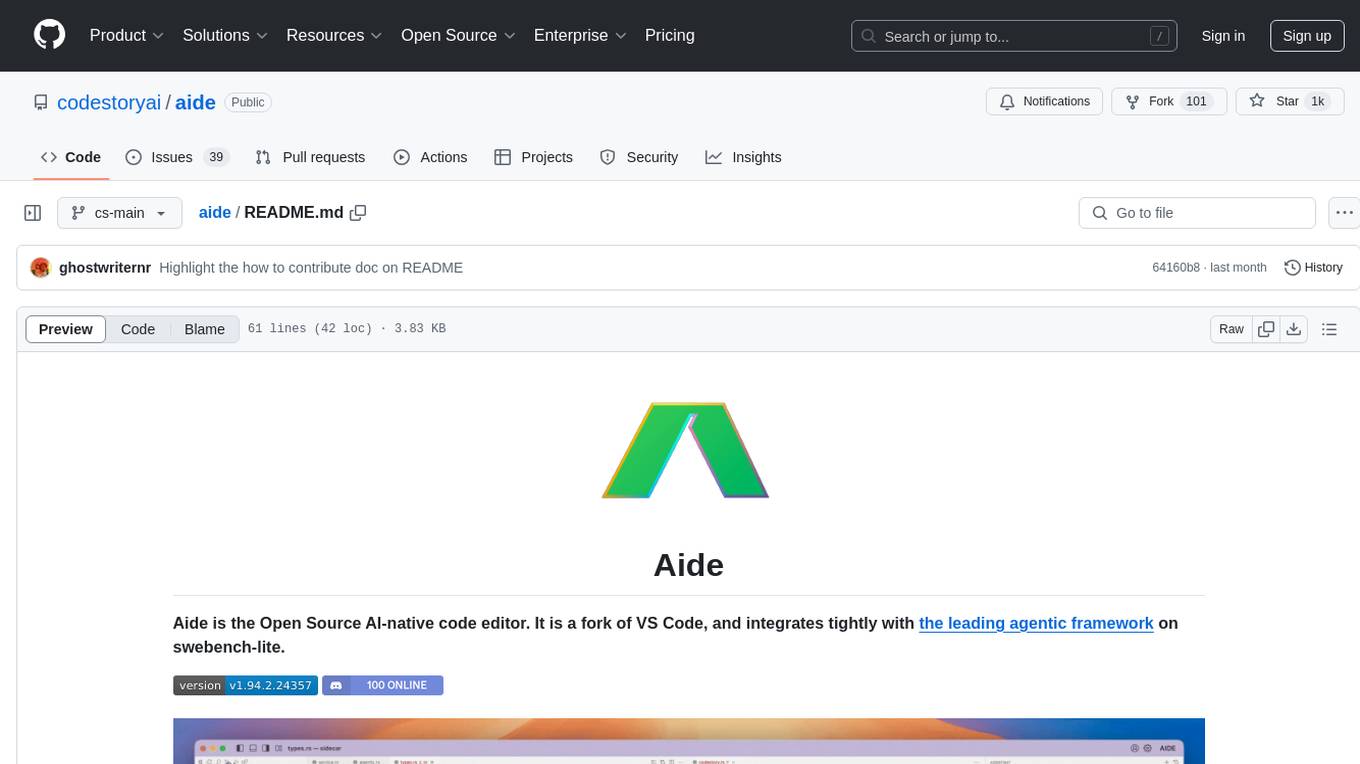
aide
Aide is an Open Source AI-native code editor that combines the powerful features of VS Code with advanced AI capabilities. It provides a combined chat + edit flow, proactive agents for fixing errors, inline editing widget, intelligent code completion, and AST navigation. Aide is designed to be an intelligent coding companion, helping users write better code faster while maintaining control over the development process.
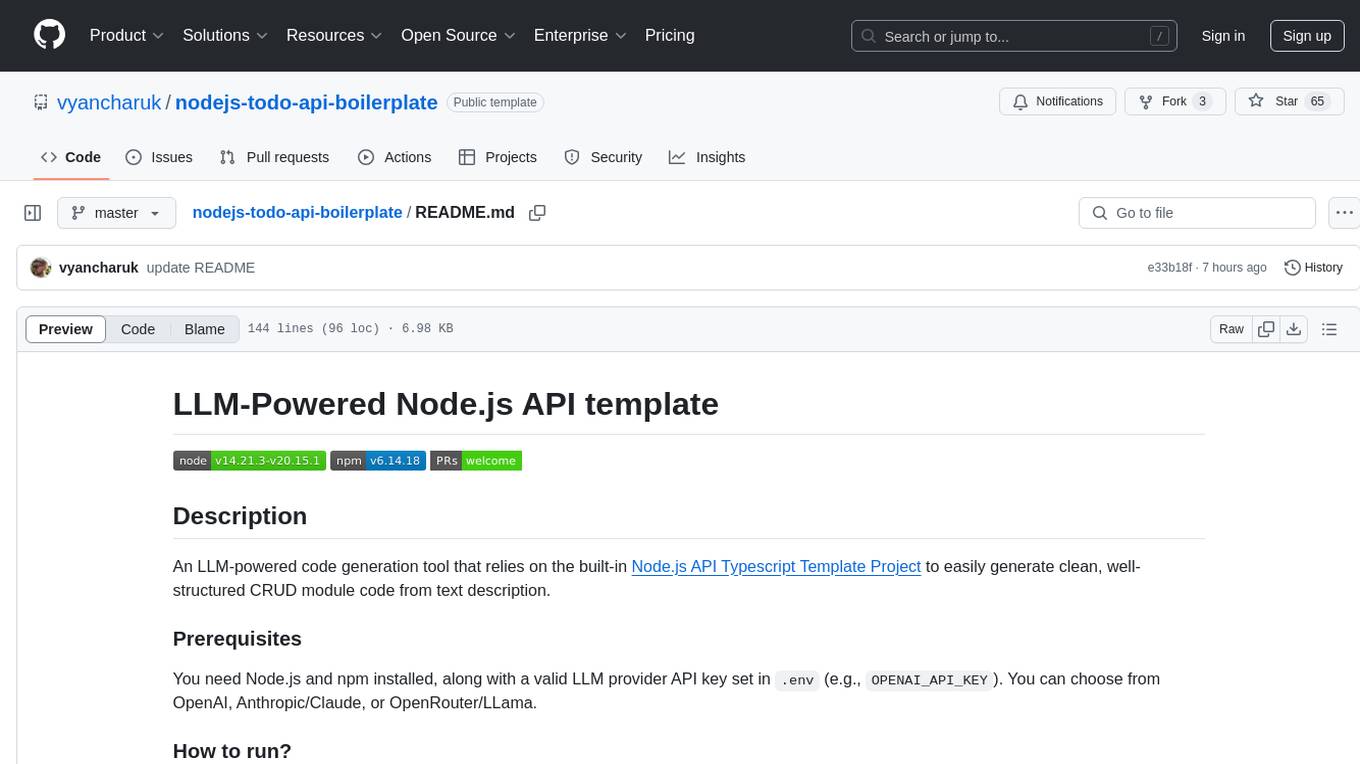
nodejs-todo-api-boilerplate
An LLM-powered code generation tool that relies on the built-in Node.js API Typescript Template Project to easily generate clean, well-structured CRUD module code from text description. It orchestrates 3 LLM micro-agents (`Developer`, `Troubleshooter` and `TestsFixer`) to generate code, fix compilation errors, and ensure passing E2E tests. The process includes module code generation, DB migration creation, seeding data, and running tests to validate output. By cycling through these steps, it guarantees consistent and production-ready CRUD code aligned with vertical slicing architecture.
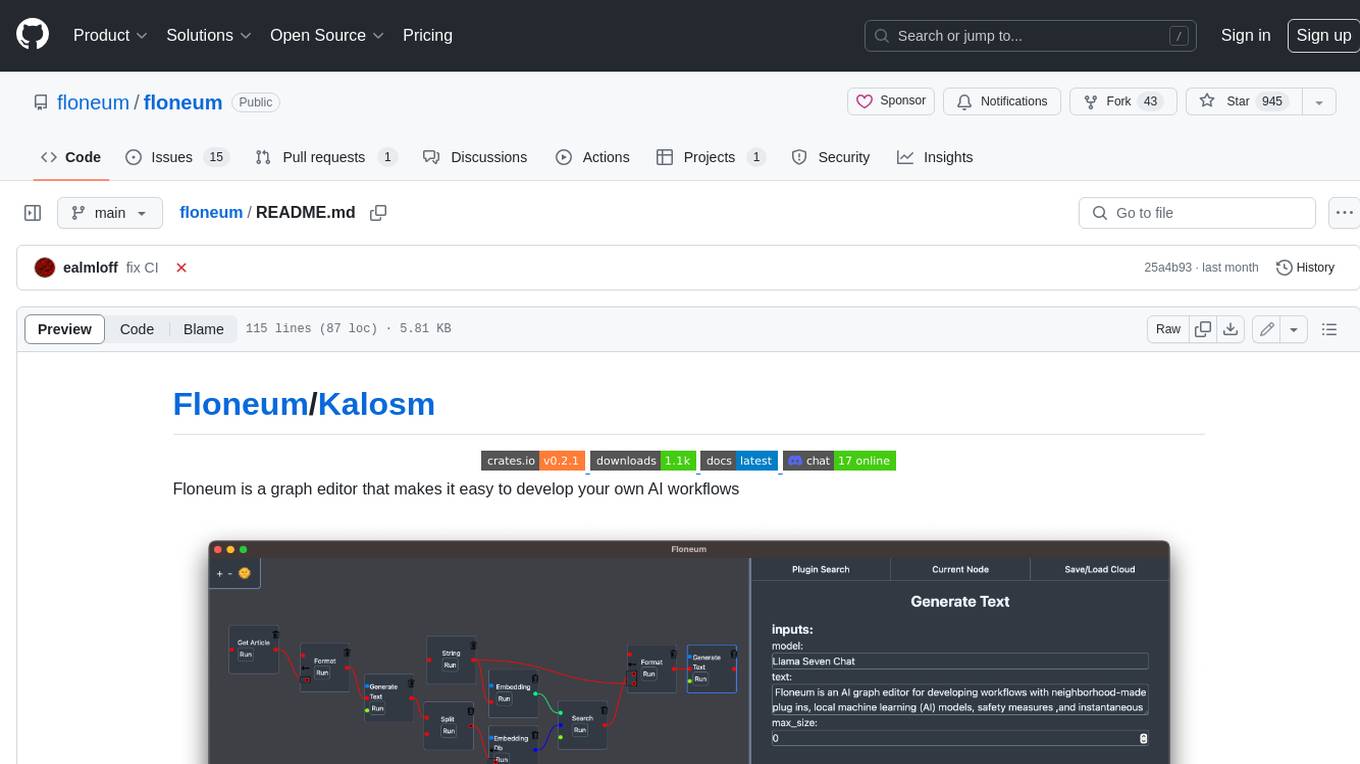
floneum
Floneum is a graph editor that makes it easy to develop your own AI workflows. It uses large language models (LLMs) to run AI models locally, without any external dependencies or even a GPU. This makes it easy to use LLMs with your own data, without worrying about privacy. Floneum also has a plugin system that allows you to improve the performance of LLMs and make them work better for your specific use case. Plugins can be used in any language that supports web assembly, and they can control the output of LLMs with a process similar to JSONformer or guidance.
For similar jobs

sweep
Sweep is an AI junior developer that turns bugs and feature requests into code changes. It automatically handles developer experience improvements like adding type hints and improving test coverage.

teams-ai
The Teams AI Library is a software development kit (SDK) that helps developers create bots that can interact with Teams and Microsoft 365 applications. It is built on top of the Bot Framework SDK and simplifies the process of developing bots that interact with Teams' artificial intelligence capabilities. The SDK is available for JavaScript/TypeScript, .NET, and Python.

ai-guide
This guide is dedicated to Large Language Models (LLMs) that you can run on your home computer. It assumes your PC is a lower-end, non-gaming setup.

classifai
Supercharge WordPress Content Workflows and Engagement with Artificial Intelligence. Tap into leading cloud-based services like OpenAI, Microsoft Azure AI, Google Gemini and IBM Watson to augment your WordPress-powered websites. Publish content faster while improving SEO performance and increasing audience engagement. ClassifAI integrates Artificial Intelligence and Machine Learning technologies to lighten your workload and eliminate tedious tasks, giving you more time to create original content that matters.

chatbot-ui
Chatbot UI is an open-source AI chat app that allows users to create and deploy their own AI chatbots. It is easy to use and can be customized to fit any need. Chatbot UI is perfect for businesses, developers, and anyone who wants to create a chatbot.

BricksLLM
BricksLLM is a cloud native AI gateway written in Go. Currently, it provides native support for OpenAI, Anthropic, Azure OpenAI and vLLM. BricksLLM aims to provide enterprise level infrastructure that can power any LLM production use cases. Here are some use cases for BricksLLM: * Set LLM usage limits for users on different pricing tiers * Track LLM usage on a per user and per organization basis * Block or redact requests containing PIIs * Improve LLM reliability with failovers, retries and caching * Distribute API keys with rate limits and cost limits for internal development/production use cases * Distribute API keys with rate limits and cost limits for students

uAgents
uAgents is a Python library developed by Fetch.ai that allows for the creation of autonomous AI agents. These agents can perform various tasks on a schedule or take action on various events. uAgents are easy to create and manage, and they are connected to a fast-growing network of other uAgents. They are also secure, with cryptographically secured messages and wallets.

griptape
Griptape is a modular Python framework for building AI-powered applications that securely connect to your enterprise data and APIs. It offers developers the ability to maintain control and flexibility at every step. Griptape's core components include Structures (Agents, Pipelines, and Workflows), Tasks, Tools, Memory (Conversation Memory, Task Memory, and Meta Memory), Drivers (Prompt and Embedding Drivers, Vector Store Drivers, Image Generation Drivers, Image Query Drivers, SQL Drivers, Web Scraper Drivers, and Conversation Memory Drivers), Engines (Query Engines, Extraction Engines, Summary Engines, Image Generation Engines, and Image Query Engines), and additional components (Rulesets, Loaders, Artifacts, Chunkers, and Tokenizers). Griptape enables developers to create AI-powered applications with ease and efficiency.